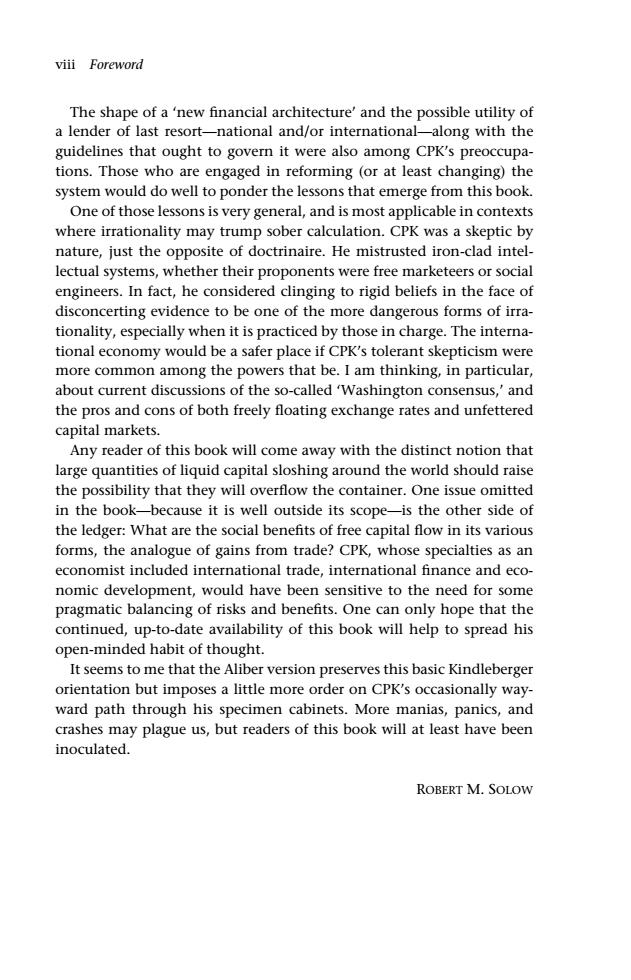正在加载图片...

vii Foreword The shape of a new financial architecture'and the possible utility of a lender of last resort-national and/or internationalalong with th guidelines that ought to govern it were also among CPK's preoccupa- tions.Those who are engaged in reforming (or at least changing)the system would do well to ponder the lessons that emerge from this book. One of those lessons is very general,and is most applicable in contexts where irrationality may trump sober calculation.CPK was a skeptic by nature,just the opposite of doctrinaire.He mistrusted iron-clad intel- lectual systems,whether their proponents were free marketeers or social engineers.In fact,he considered clinging to rigid beliefs in the face of disconcerting evidence to be one of the more dangerous forms of irra- tionality,especially when it is practiced by those in charge.The interna tional economy would be a safer place if CPK's tolerant skepticism were more common among the powers that be.I am thinking,in particular, about current discussions of the so-called 'Washington consensus,'and the pros and cons of both freely floating exchange rates and unfettered capital markets. Any reader of this book will come away with the distinct notion that large quantities of liquid capital sloshing around the world should raise the possibility that they will overflow the container.One issue omitted in the book-because it is well outside its scope-is the other side of the ledger:What are the social benefits of free capital flow in its various forms,the analogue of gains from trade?CPK,whose specialties as an economist included international trade,international finance and eco- nomic development,would have been sensitive to the need for some pragmatic balancing of risks and benefits.One can only hope that the continued,up-to-date availability of this book will help to spread his open-minded habit of thought. It seems to me that the Aliber version preserves this basic Kindleberger orientation but imposes a little more order on CPK's occasionally way- ward path through his specimen cabinets.More manias,panics,and crashes may plague us,but readers of this book will at least have been inoculated. ROBERT M.SOLOW FM JWBK120/Kindleberger February 13, 2008 14:53 Char Count= viii Foreword The shape of a ‘new financial architecture’ and the possible utility of a lender of last resort—national and/or international—along with the guidelines that ought to govern it were also among CPK’s preoccupations. Those who are engaged in reforming (or at least changing) the system would do well to ponder the lessons that emerge from this book. One of those lessons is very general, and is most applicable in contexts where irrationality may trump sober calculation. CPK was a skeptic by nature, just the opposite of doctrinaire. He mistrusted iron-clad intellectual systems, whether their proponents were free marketeers or social engineers. In fact, he considered clinging to rigid beliefs in the face of disconcerting evidence to be one of the more dangerous forms of irrationality, especially when it is practiced by those in charge. The international economy would be a safer place if CPK’s tolerant skepticism were more common among the powers that be. I am thinking, in particular, about current discussions of the so-called ‘Washington consensus,’ and the pros and cons of both freely floating exchange rates and unfettered capital markets. Any reader of this book will come away with the distinct notion that large quantities of liquid capital sloshing around the world should raise the possibility that they will overflow the container. One issue omitted in the book—because it is well outside its scope—is the other side of the ledger: What are the social benefits of free capital flow in its various forms, the analogue of gains from trade? CPK, whose specialties as an economist included international trade, international finance and economic development, would have been sensitive to the need for some pragmatic balancing of risks and benefits. One can only hope that the continued, up-to-date availability of this book will help to spread his open-minded habit of thought. It seems to me that the Aliber version preserves this basic Kindleberger orientation but imposes a little more order on CPK’s occasionally wayward path through his specimen cabinets. More manias, panics, and crashes may plague us, but readers of this book will at least have been inoculated. ROBERT M. SOLOW